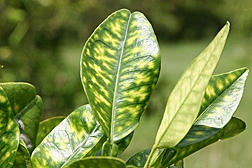This page has been archived and is being provided for reference purposes only. The page is no longer being updated, and therefore, links on the page may be invalid.
| Read the magazine story to find out more. |
|
|
|
|
Technology Reveals Citrus Greening-Infected Trees
By Sharon DurhamAugust 8, 2011
U.S. Department of Agriculture (USDA) scientists are using a technology known as "Fourier transform infrared-attenuated total reflection" (FTIR-ATR) spectroscopy to rapidly identify with 95 percent accuracy citrus plant leaves infected with the devastating disease known as citrus greening.
Scientists from the Agricultural Research Service (ARS) Subtropical Plant Pathology Research Unit in Fort Pierce, Fla., and the agency's Quality and Safety Assessment Research Unit in Athens, Ga., collaborated on the use of FTIR-ATR spectroscopy to identify citrus greening in plants. ARS is the chief intramural scientific research agency of USDA, and this work supports the USDA priority of promoting international food security.
Citrus plants are highly susceptible to citrus greening, also known as Huanglongbing. The disease was discovered in Florida in 2005 and is rapidly spreading in the citrus-growing regions of the state. Fruit from infected trees drops prematurely or fails to ripen.
The current method for detecting citrus greening-infected trees is a type of DNA testing called polymerase chain reaction, which is both costly and time-consuming. FTIR uses light to identify chemicals and reactions in a sample. This technology has the potential to detect the disease before visible symptoms occur, and it is cheaper and faster than the DNA testing.
To test for the presence of the disease, researchers removed a leaf from a citrus tree, dried it out in a microwave, and ground it into a powder. A very small sample of the leaf powder was placed on top of an ATR plate. The system clearly distinguished citrus greening-infected leaves from healthy leaves. The scientists say more work will be need to diferentiate between leaves infected with citrus greening and those infected with other citrus diseases.
The Fort Pierce team included physical scientist Gavin Poole and research leader Tim Gottwald, while the Athens team was comprised of chemist Samantha Hawkins, engineer Bosoon Park, physiologist William Windham and research leader Kurt Lawrence.
Results of this research were published in Applied Spectroscopy in 2010.
Read more about this research in the August 2011 issue of Agricultural Research magazine.

